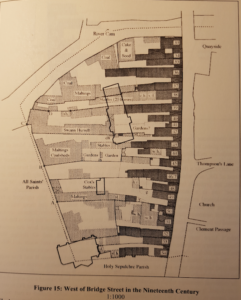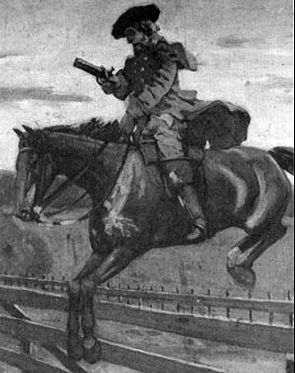Search by topic
- archaeology
- architecture
- bricklayer
- Building of Local Interest
- carpenter
- church
- crime
- dressmaker
- fire
- general labourer
- Great Eastern Railway
- listed building
- medieval
- oral history
- Public House
- Rattee & Kett
- Roman
- scholar
- school
- Then and Now
- tudor
- women
- work
- world war one
- world war two
Search by text
 47 Bridge Street, 1937(Cambridgeshire Collection)
47 Bridge Street, 1937(Cambridgeshire Collection)46 / 47 Bridge Street, (the White Swan / Red Lion)
History of 47 Bridge Street
c. 1275: Nicholas Childman
1483 John Bell (I) bought land next to his tenement le Swanne.
1525 death of Simon Rankyn. In his will the house is ‘called the sign of the Swan’.
1530 Geoffrey Rankyn, Simon’s executor, let a tenement, inn and brewhouse called the White Swan [in St Clement’s]’ to Richard Hardwicke.
1536 property sold to Richard Harwicke for £60.
1545 left to his daughter Lucy and her uncle, Thomas Hardwicke of Yorkshire let it in 1559 to John Snoden.
1564 sold to William Hodson brewer in 1564.
1565 sold to Thomas Paris.
1571 sold by Paris and Hodson for £150 to Thomas Hodilowe and his wife Joan.
1573 Hodilowes sold it to St John’s. The college seems to have then let the inn but kept the brewhouse under its own management until 1609.
1573 inn in tenure of William Munnes and John Sawood. rent £4 10s p.a.
c. 1597: inn leased by Thomas Smith, the University Megistrary.
1606 James Tabor, successor University Registrary, took over lease of inn.
1606-77 lived in by Tabors; not in Lent Book and no longer an inn
1609 brewhouse leased to Anne Cropley
1614 brewhouse leased to Robert Lukin.
1616 brewhouse leased to Thomas Jackson, tailor.
1632 Tabor granted a new lease to inn.
1636 Tabor renting inn and brewhouse.
1672-74 not listed in Victuallers’ Book
1707/8 Nicholas Tabor II becomes leaseholder. Swan is renamed Red Lion about this time.
1752-67 Not listed in Victuallers’ Book
1768-1856 Old Red Lion listed continuously
1782 earliest reference to Red Lion but there was a Swan on Quayside by 1723.
1783 William Coulson, publican (records of the Parish of St Clement)
occupied by Thomas Nutting
1803 estate contained ‘Red Lion Public House’, granaries, two messuages, a coal yard with chambers over it, and stables which were sub-let.
Renamed ‘Old Red LIon’ and remained in business under that name until c. 1908.
1830 Samuel Bouttell (Pigot’s)
1839 William Watts (Pigot’s)
1851 William Watts (Gardner’s)
1852 William Watts (Slaters)
1861
Alice Watts, publican, widow, 63, b Cambridge
Emma Evans, servant, 16, b Cambridge
James Phillips, lodger, tobacconist, 22, b Grantchester
1867 John Stokes (Mathieson’s)
1869 John Stokes (Post Office Directory)
1871
Walter Houston, publican, 35, b Scotland
Elizabeth E Houston, 37, b London
James A Carrick, lodger, BA Cambridge Univ, 41, b Liverpool
Josiah Munsey, lodger, cricketer, 35, b Cambridge
1878 Henry Warrington, publican (Spalding’s)
1879 J P Warrington, (Post Office Directory)
1881
James P Warrington, college servant & publican, 38, b Cambridge
Elizabeth Warrington, 33, b Cambridge
Harry Warrington, 9, b Cambridge
Ellen M Warrington, 8, b Cambridge
Percy J Warrington, 4, b Cambridge
Frank W Warrington, 2, b Cambridge
Gertrude E Warrington, 8 month, b Cambridge
Sarah Starling, servant, 16, b Oldham
1888 J P Warrington (Kellys Directory)
1911
George Philip Philo, 46, furniture designer and cabinet maker also pattern maker, b Cambridge
Jessie, 38, b Cambridge
Margaret, 14, b Cambridge
Philip John, 13, b Cambridge
George Gergus Mark, 8, b Cambridge
Owen, 6, b Cambridge
Hilda, 5, b Cambridge
Jessie Ferguson, 3, b Cambridge
Mabel Dellar, 25, housemaid, b Oakington
Rachel Smith, 19, housemaid, b Cambridge
1913
G P Philo, furniture maker and designer
1938
(47) Biggs the florist
Contribute
Do you have any information about the people or places in this article? If so, then please let us know using the Contact page or by emailing capturingcambridge@
License
 This work is licensed under a Creative Commons Attribution-NonCommercial-ShareAlike 4.0 International License.
This work is licensed under a Creative Commons Attribution-NonCommercial-ShareAlike 4.0 International License.












